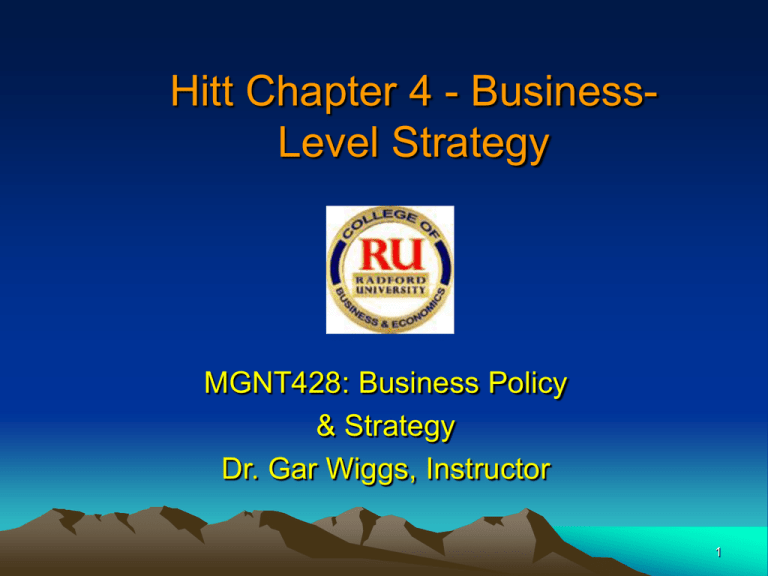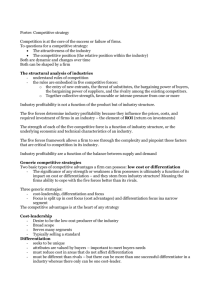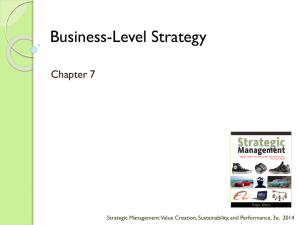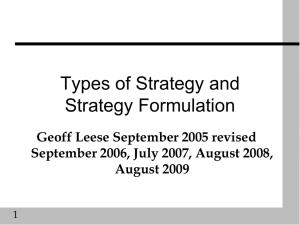
Hitt Chapter 4 - BusinessLevel Strategy
MGNT428: Business Policy
& Strategy
Dr. Gar Wiggs, Instructor
1
Knowledge Objectives
• Studying this chapter
should provide you with
the strategic
management knowledge
needed to:
– Define business-level
strategy.
– Discuss the relationship
between customers and
business-level strategies in
terms of who, what, and
how.
– Explain the differences
among business-level
strategies.
– Use the five forces of
competition model to
explain how above-average
returns can be earned
through each businesslevel strategy.
– Describe the risks of using
each of the business-level
strategies.
2
The Strategic
Management
Process
Figure 1.1
Copyright © 2004 South-Western. All rights reserved.
3
Business-Level Strategy (Defined)
• An integrated and coordinated set of
commitments and actions the firm uses to
gain a competitive advantage by exploiting
core competencies in specific product
markets
4
Business-Level Strategy
Key Issues
Business-level
Strategy
Which good or
service to provide
How to
manufacture it
How to
distribute it
5
Core Competencies and
Strategy
Core
Competencies
Resources and superior capabilities that are
sources of competitive advantage over a
firm’s rivals
Strategy
An integrated and coordinated set of
actions taken to exploit core competencies
and gain competitive advantage
Business-level
Strategy
Providing value to customers and gaining
competitive advantage by exploiting core
competencies in individual product markets
6
Customers: Business-Level
Strategic Issues
• Customers are the foundation of
successful business-level strategy
– Who will be served by the strategy?
– What needs those target customers have that
the strategy will satisfy?
– How those needs will be satisfied by the
strategy?
7
Customers: Who, What, Where
• Firms must manage all aspects of their
relationship with customers
– Reach: firm’s success and connection to
customers
– Richness: depth and detail of two-way flow of
information between the firm and the
customer
– Affiliation: facilitation of useful interactions
with customers
8
Customer Needs—Who?
Determining the Customers to Serve
Consumer
Markets
Customers
Industrial
Markets
Market Segmentation
9
Basis for Customer Segmentation
Consumer Markets
1. Demographic factors (age, income, sex, etc.)
2. Socioeconomic factors (social class, stage in
the family life cycle)
3. Geographic factors (cultural, regional, and
national differences)
4. Psychological factors (lifestyle, personality traits)
5. Consumption patterns (heavy, moderate, and
light users)
6. Perceptual factors (benefit segmentation,
perceptual mapping)
Table 4.1
SOURCE: Adapted from S. C. Jain, 2000, Marketing Planning and
Strategy, Cincinnati: South-Western College Publishing, 120.
10
Basis for Customer Segmentation
(cont’d.)
Industrial Markets
1. End-use segments (identified by SIC code)
2. Product segments (based on technological
differences or production economics)
3. Geographic segments (defined by boundaries
between countries or by regional differences
within them)
4. Common buying factor segments (cut across
product market and geographic segments)
5. Customer size segments
Table 4.1
SOURCE: Adapted from S. C. Jain, 2000, Marketing Planning and
Strategy, Cincinnati: South-Western College Publishing, 120.
11
Market Segmentation:
Consumer Markets
Demographic factors
Perceptual
Demographic
Socioeconomic factors
Consumer
Socioeconomic Geographic factors
Markets
Psychological factors
Consumption
Psychological Geographic
Consumption patterns
Perceptual factors
12
Market Segmentation: Industrial
Markets
End-use segments
Product segments
Customer size
Geographic segments
Common buying factor
segments
End-use
Industrial
Markets Product
Common
buying factor
Geographic
Customer size segments
13
Customer Needs—What?
• Customer Needs to Satisfy
– Customer needs are related to a product’s
benefits and features
– Customer needs are neither right nor wrong,
good nor bad
– Customer needs represent desires in terms of
features and performance capabilities
14
Customer Needs—How?
• Determining the Core Competencies
Necessary to Satisfy Customer Needs
– Firms use core competencies to implement
value creating strategies that satisfy
customers’ needs
– Only firms with capacity to continuously
improve, innovate and upgrade their
competencies can expect to meet and/or
exceed customer expectations across time
15
Types of Business-Level
Strategy
• Business-Level Strategies
– Are intended to create differences between
the firm’s position relative to those of its rivals
• To position itself, the firm must decide
whether it intends to:
– Perform activities differently or
– Perform different activities as compared to its
rivals
16
Types of Potential Competitive
Advantage
• Achieving lower overall costs than rivals
– Performing activities differently (cheaper
process)
• Possessing the capability to differentiate
the firm’s product or service and command
a premium price
– Performing different (valuable) activities
17
Two Targets of Competitive
Scope
• Broad Scope
– The firm competes in many customer
segments
• Narrow Scope
– The firm selects a segment or group of
segments in the industry and tailors its
strategy to serving them at the exclusion of
others
18
Southwest Airlines’ Activity
System
19
Five BusinessLevel
Strategies
SOURCE: Adapted with the
permission of The Free Press, an
imprint of Simon & Schuster Adult
Publishing Group, from Competitive
Advantage: Creating and Sustaining
Superior Performance, by Michael E.
Porter, 12. Copyright © 1985, 1998
by Michael E. Porter.
Figure 4.1
20
Cost Leadership Strategy
• An integrated set of actions taken to produce
goods or services with features that are
acceptable to customers at the lowest cost,
relative to that of competitors with features that
are acceptable to customers
– Relatively standardized products
– Features acceptable to many customers
– Lowest competitive price
21
Cost Leadership Strategy
• Cost saving actions required by this
strategy:
– Building efficient scale facilities
– Tightly controlling production costs and overhead
– Minimizing costs of sales, R&D and service
– Building efficient manufacturing facilities
– Monitoring costs of activities provided by outsiders
– Simplifying production processes
22
How to Obtain a Cost Advantage
Determine and
control
Reconfigure, if
needed
Cost Drivers Value Chain
Alter production process
New raw material
Change in automation
Forward integration
New distribution channel
Backward integration
Change location relative
to suppliers or buyers
New advertising media
Direct sales in place of
indirect sales
23
Examples
of ValueCreating
Activities
Associated
with the
Cost
Leadership
Strategy
SOURCE: Adapted with the permission of The Free Press, an imprint of Simon & Schuster Adult Publishing Group, from Competitive
Advantage: Creating and Sustaining Superior Performance, by Michael E. Porter, 47. Copyright © 1985, 1998 by Michael E. Porter.
Figure 4.2
24
Value-Creating Activities for Cost
Leadership
• Cost-effective MIS
• Few management layers
• Simplified planning
• Consistent policies
• Effecting training
• Easy-to-use manufacturing
technologies
• Investments in technologies
• Finding low cost raw materials
• Monitor suppliers’
performances
• Link suppliers’ products to
production processes
• Economies of scale
• Efficient-scale facilities
• Effective delivery schedules
• Low-cost transportation
• Highly trained sales force
• Proper pricing
25
Cost Leadership Strategy:
New Entrants
The Threat of
Potential Entrants
• Can frighten off new
entrants due to:
– Their need to enter on a
large scale in order to be
cost competitive
– The time it takes to move
down the learning curve
26
Cost Leadership Strategy: Suppliers
Bargaining Power
of Suppliers
• Can mitigate suppliers’
power by:
– Being able to absorb cost
increases due to low cost
position
– Being able to make very
large purchases, reducing
chance of supplier using
power
27
Cost Leadership Strategy: Buyers
Bargaining Power
of Buyers
• Can mitigate buyers’
power by:
– Driving prices far below
competitors, causing them
to exit, thus shifting power
with buyers back to the
firm
28
Cost Leadership Strategy: Substitutes
Product Substitutes
• Cost leader is well
positioned to:
– Make investments to be
first to create substitutes
– Buy patents developed by
potential substitutes
– Lower prices in order to
maintain value position
29
Cost Leadership Strategy: Competitors
Rivalry with
Existing Competitors
• Due to cost leader’s
advantageous position:
– Rivals hesitate to compete
on basis of price
– Lack of price competition
leads to greater profits
30
Cost Leadership Strategy (cont’d’)
• Competitive Risks
– Processes used to produce and distribute
good or service may become obsolete due to
competitors’ innovations
– Focus on cost reductions may occur at
expense of customers’ perceptions of
differentiation
– Competitors, using their own core
competencies, may successfully imitate the
cost leader’s strategy
31
Differentiation Strategy
• An integrated set of actions taken to produce
goods or services (at an acceptable cost) that
customers perceive as being different in ways
that are important to them
– Nonstandardized products
– Customers value differentiated features more
than they value low cost
32
How to Obtain a Differentiation
Advantage
Control if needed
Cost Drivers
Reconfigure to
maximize
Value Chain
Lower buyers’ costs
Raise performance of product or service
Create sustainability through:
Customer perceptions of uniqueness
Customer reluctance to switch to nonunique product or service
33
Value-Creating Activities and
Differentiation
• Highly developed MIS
• Emphasis on quality
• Worker compensation for
creativity/productivity
• Use of subjective
performance measures
• Basic research capability
• Technology
• High quality raw materials
• Delivery of products
• High quality replacement
parts
• Superior handling of
incoming raw materials
• Attractive products
• Rapid response to
customer specifications
• Order-processing
procedures
• Customer credit
• Personal relationships
34
Examples
of ValueCreating
Activities
Associated
with the
Differentiation
Strategy
Figure 4.3
SOURCE: Adapted with the permission of The Free Press, an imprint of Simon & Schuster Adult Publishing Group, from Competitive
Advantage: Creating and Sustaining Superior Performance, by Michael E. Porter, 47. Copyright © 1985, 1998 by Michael E. Porter.
35
Differentiation Strategy: New Entrants
The Threat of
Potential Entrants
• Can defend against new
entrants because:
– New products must
surpass proven products
– New products must be at
least equal to
performance of proven
products, but offered at
lower prices
36
Differentiation Strategy: Suppliers
Bargaining Power
of Suppliers
• Can mitigate suppliers’
power by:
– Absorbing price
increases due to higher
margins
– Passing along higher
supplier prices because
buyers are loyal to
differentiated brand
37
Differentiation Strategy: Buyers
Bargaining Power
of Buyers
• Can mitigate buyers’
power because well
differentiated products
reduce customer
sensitivity to price
increases
38
Differentiation Strategy: Substitutes
Product Substitutes
• Well positioned relative
to substitutes because
– Brand loyalty to a
differentiated product
tends to reduce
customers’ testing of new
products or switching
brands
39
Differentiation Strategy:
Competitors
Rivalry with
Existing Competitors
• Defends against
competitors because
brand loyalty to
differentiated product
offsets price
competition
40
Competitive Risks of Differentiation
• The price differential between the differentiator’s
product and the cost leader’s product becomes
too large
• Differentiation ceases to provide value for which
customers are willing to pay
• Experience narrows customers’ perceptions of
the value of differentiated features
• Counterfeit goods replicate differentiated
features of the firm’s products
41
Focus Strategies
• An integrated set of actions taken to
produce goods or services that serve the
needs of a particular competitive segment
– Particular buyer group (e.g. youths or senior citizens
– Different segment of a product line (e.g. professional
craftsmen versus do-it-yourselfers
– Different geographic markets (e.g. East coast versus
West coast)
42
Focus Strategies (cont’d.)
• Types of focused strategies
– Focused cost leadership strategy
– Focused differentiation strategy
• To implement a focus strategy, firms must
be able to:
– Complete various primary and support
activities in a competitively superior manner,
in order to develop and sustain a competitive
advantage and earn above-average returns
43
Factors That Drive Focused Strategies
• Large firms may overlook small niches.
• A firm may lack the resources needed to
compete in the broader market
• A firm is able to serve a narrow market segment
more effectively than can its larger industry-wide
competitors
• Focusing allows the firm to direct its resources to
certain value chain activities to build competitive
advantage
44
Competitive Risks of Focus Strategies
• A focusing firm may be “outfocused” by its
competitors
• A large competitor may set its sights on a firm’s
niche market
• Customer preferences in niche market may
change to more closely resemble those of the
broader market
45
Integrated Cost Leadership/
Differentiation Strategy
• A firm that successfully uses an integrated
cost leadership/differentiation strategy
should be in a better position to:
– Adapt quickly to environmental changes
– Learn new skills and technologies more
quickly
– Effectively leverage its core competencies
while competing against its rivals
46
Integrated Cost Leadership/
Differentiation Strategy (cont’d.)
• Commitment to strategic flexibility is
necessary for implementation of integrated
cost leadership/differentiation strategy
– Flexible manufacturing systems
– Information networks
– Total quality management (TQM) systems
47
Flexible Manufacturing Systems
• Computer-controlled processes used to
produce a variety of products in moderate,
flexible quantities with a minimum of
manual intervention
– Goal is to eliminate the “low-cost-versus-wide
product-variety” tradeoff
– Allows firms to produce large variety of
products at relatively low costs
48
Information Networks
• Link companies electronically with their
suppliers, distributors, and customers
– Facilitate efforts to satisfy customer
expectations in terms of product quality and
delivery speed
– Improve flow of work among employees in the
firm and their counterparts at suppliers and
distributors
49
Total Quality Management (TQM) Systems
• Emphasize total commitment to the
customer through continuous improvement
using:
– Data-driven, problem-solving approaches
– Empowerment of employee groups and teams
• Benefits
– Increases customer satisfaction
– Cuts costs
– Reduces time-to-market for innovative
products
50
Risks of the Integrated Cost
Leadership/ Differentiation Strategy
• Often involves compromises
– Becoming neither the lowest cost nor the
most differentiated firm
• Becoming “stuck in the middle”
– Lacking the strong commitment and expertise
that accompanies firms following either a cost
leadership or a differentiated strategy
51
Generic Corporate
Strategies . . .
• Growth Strategies:
– Forward Integration
– Backward Integration
– Horizontal Integration
• Stabilization Strategies:
–
–
–
–
–
Market penetration
Market development
Product development
Concentric diversification
Conglomerate
diversification
– Horizontal diversification
– Joint ventures
52
More Generic Strategies …
• Retrenchment/Closure
– Retrenchment
– Divestiture
– Liquidation
53






